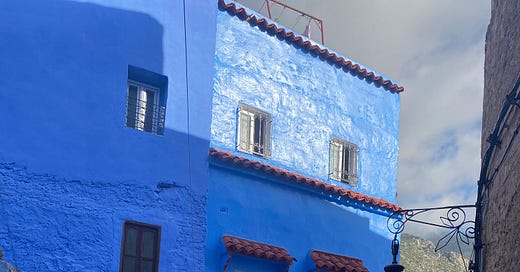Everywhere Em: Chefchaouen, Morocco
Em visits the Blue Pearl of Morocco. Plus an ode to Abdul the hostel manager.
You’re probably already familiar with Chefchaouen, the Moroccan city known for its vibrantly blue walls and stairs. You’ve surely seen an Instagram influencer in a flowy maxi skirt, a wide-brimmed sunhat on her head, using the Blue Pearl as a picture-perfect backdrop. And while Chefchaouen is indisputably photogenic and oh so BLUE, there’s more to appreciate in this charming city that just its blue pigment.
This part of the trip was characterized by unexpectedly nourishing hostel-breakfasts, bargaining with local shopkeepers, befriending stray cats, and hiking to a waterfall.
Riad Sakura
We stayed in Riad Sakura — a hostel located in a narrow building with steep stairs, colorful walls, and an out of place, vaguely Japanese-themed lobby. Our experience at Riad Sakura was much more quirky as compared to our stay in Tetuan (you can read more about that here) — like the mildly leaking bathroom sink and the eccentric hostel owner — but these quirks truly added to the experience. Some of my favorite memories from my time in Morocco took place at the Riad Sakura, in fact.
When we arrived to check in, we found ourselves in a strangely empty and quiet lobby. We rang the bell on the desk and waited for a few moments. Eventually we learned that the host was out running errands, and so we were greeted by a handyman painting the interior stairs instead.
We went out for lunch, and when we returned our host was there waiting for us. Seemingly the only guests at the hostel in the December off-season, Abdul (the owner or manager, I’m not sure) gave us a different room than we had booked. He insisted, citing nicer views and more natural light. We were sure to clarify that the cost would be the same, and he insisted, “Yes, yes! The same price- no worries!”. Abdul was always insisting, I would come to learn.
Our room was nice. Not pristine, hotel-quality, but clean, with warm comforters and colorful rugs. Our windows opened out onto a plaza of the city, from where you could see the main Bab of (a gate or entry-point into) the medina. Beyond all of this was a stunning backdrop of lush green mountains.
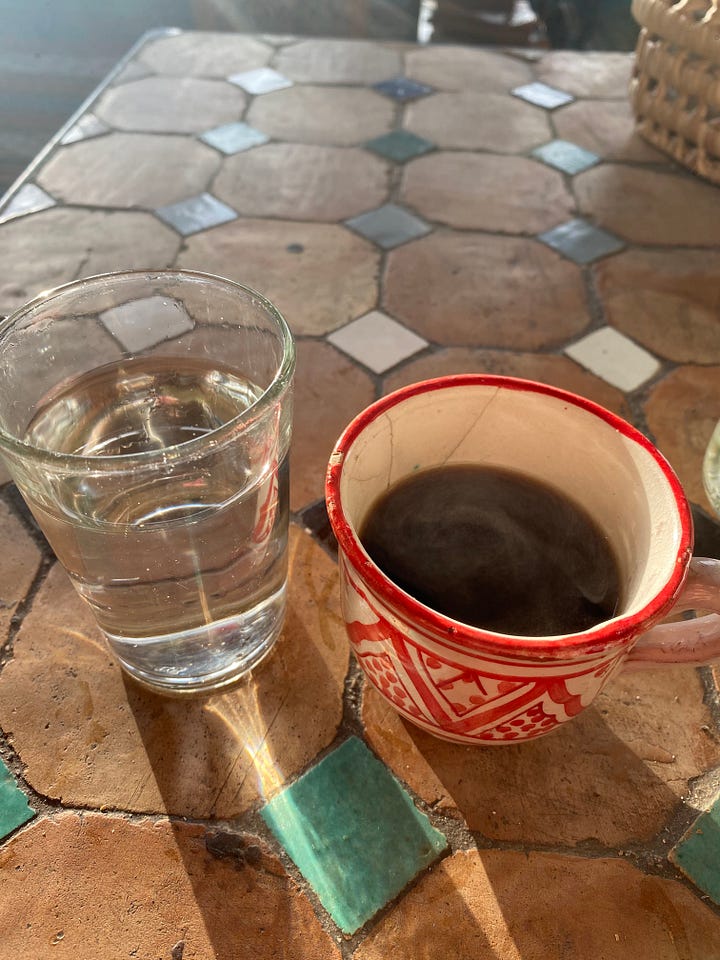
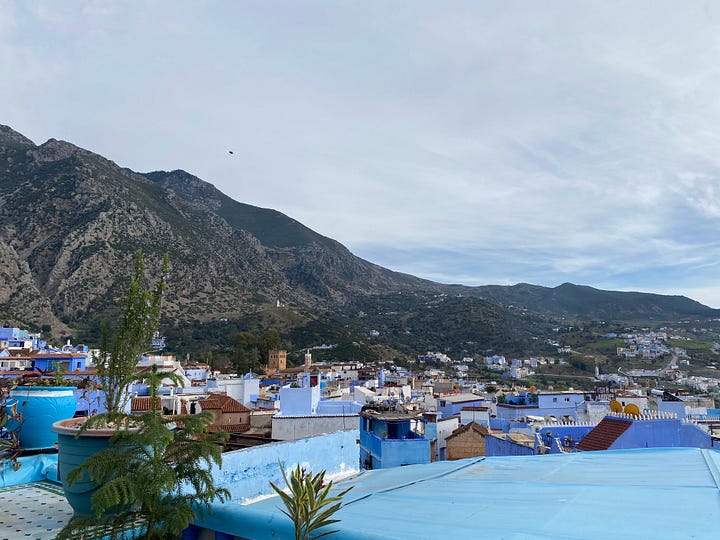
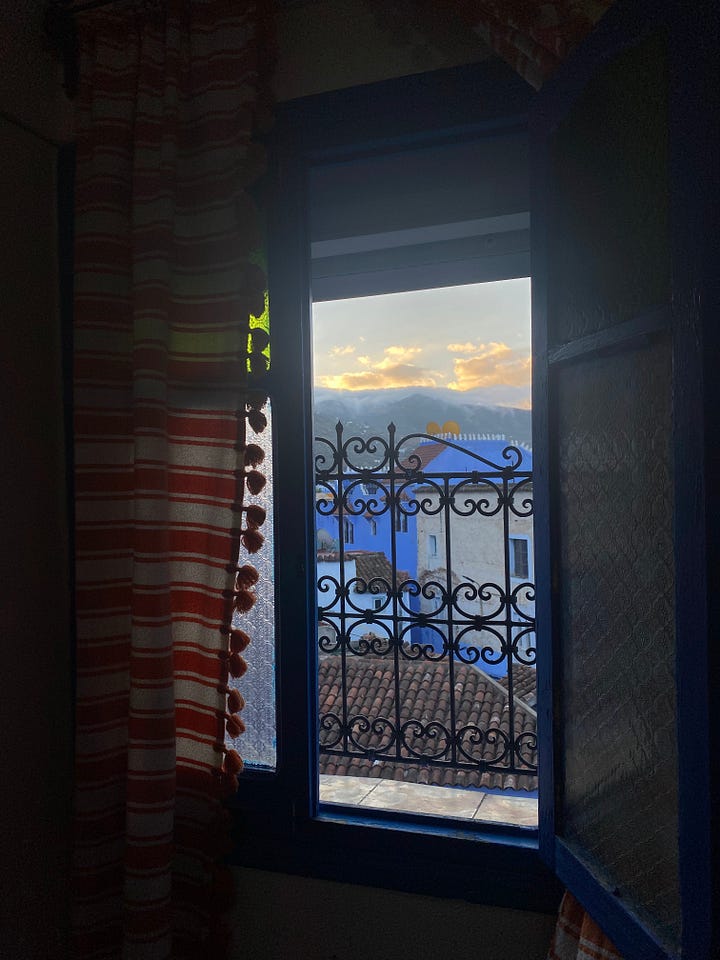

The morning after our first night at Riad Darna, we checked out the covered open-air balcony of the third floor of the hostel. Abdul was up already, and prepared us a delicious Moroccan coffee — coffee infused with spices like cinnamon, cardamom, anis, and nutmeg. Abdul served unlimited Moroccan coffee and — in his sort of haphazard, hyperactive way of speaking, — explained how it is made. That you must be careful not to make it too spicy. That the coffee must be hot enough to dissolve your spice mixture, but not too hot so as to burn them. The coffee, on a brisk early morning, warms you from within and instantly made me feel at home as I sat back on the cushioned benches and looked out at the mountains.
We discovered an unknown hostel guest who had, in fact, also been staying at the riad. He was at the balcony that morning as well, sipping on a soup and eating some bread. Abdul clumsily explained that we weren’t up early enough for breakfast today (it was 7 am, but okay), but he handed us a large bottle of water. “Today, this water… for you, it’s free okay? Maybe tomorrow no, but today it’s free”.
I got the impression that it was a one-man operation here, and that Abdul that morning was simply finished cooking. He had forgotten about the two additional guests, or assumed we wouldn’t be up to see the soup and bread, and — because he is a welcoming host, after all — became frazzled and offered us water instead. We hadn’t paid for breakfast to be included in our stay, so it really was of no consequence.
I enjoyed Abdul, despite his oddities. When we finally got to try the breakfast the following morning, he gave us helpful information on taxiing to Akchour falls (more below on that), emphatically encouraging us that we must go — it’s beautiful this time of year — and even better if we go in the morning before it gets too hot or crowded. This breakfast at the riad was genuinely one of my favorite memories from the trip. We were presented with a generous breakfast spread, with dishes that just kept coming, presented to us by Abdul of course. We had a nutty and warm split pea soup, olives, Khobz (a traditional Moroccan bread served with almost every meal), butter, and jam, all accompanied with both Moroccan mint tea and spiced coffee. Everything felt warm and nourishing and cozy and healthy and homemade. Abdul would keep coming back, insisting: “Here, you must try the soup with some chili pepper”, or “The jam and butter is something sweet. You must have something sweet to go with the salty”.
Perhaps it’s a difference in culture or simply in personality, but I grew to appreciate Abdul’s insistence and expertise as thoughtfulness and hospitality, even if I sometimes didn’t know where it was going. Would we be charged extra for the water bottle he gave us? (We weren’t). How many more dishes would be coming out? How do I gently decline and tell him I don’t like olives? (The answer is that you don’t, and you try Moroccan green olives, and you discover that you might actually like olives after all. Maybe.)
Abdul epitomizes the hospitality of Morocco. How proud the people there are of their food and their culture. They will be so happy that you have come there to visit. They will tell you how you should enjoy your soup, that you should have the tea now because it’s warm and will start your digestion for the day, and that it’s better to walk up to the Spanish mosque in the evening but to remember that you won’t see the sunset because of the mountains. This goes beyond the detail-oriented character and efficiency of a hotel concierge: this is the careful and thoughtful hospitality of a quaint and quirky hostel that is operated by a local.
Akchour Waterfalls
When I think of Morocco, I think of barren landscapes, camels, and the Sahara desert. That will have to be my next trip to the country, because this trip was full of lush scenery and mountains. Our half-day trip to Akchour falls was a relaxing escape into nature. It’s only a 45 minute drive from Chefchaouen — maybe 60 minutes after you account for the pitstop our taxi driver took, stopping at a gas station for his Moroccan mint tea to-go, something I couldn’t help but laugh at. They’re serious about their tea, you guys!
While the full hike at Akchour can seemingly be quite intense and takes a few hours to do (we were repeatedly passed by hikers with trekking poles and other serious hiking gear), there is a smaller loop which takes you around the base of the cascades, with small footbridges that allow you to cross the vibrantly teal water below.

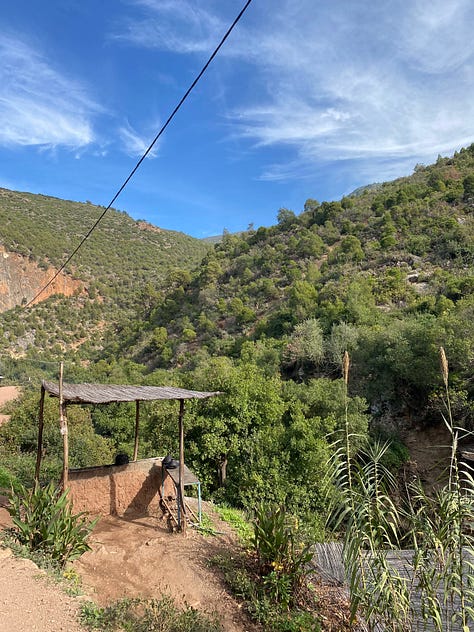
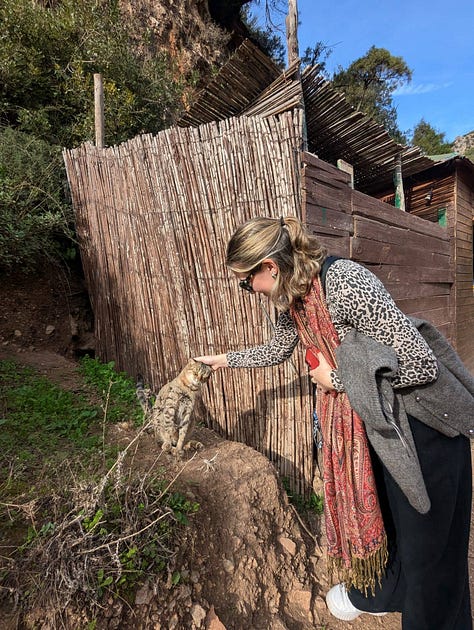
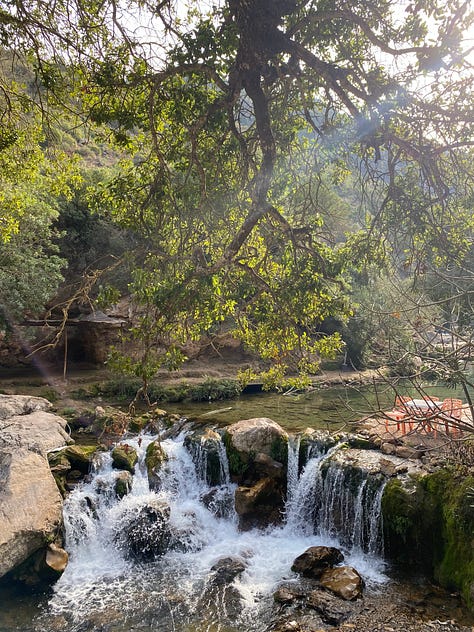

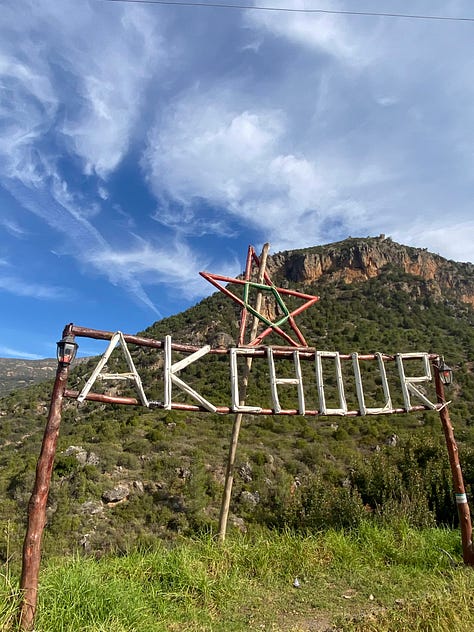
We smelled the smoke of the backwoods tagines sitting on fires outside modest looking homes. Plastic backyard chairs line parts of the riverbank so you can enjoy a mint tea or some tagine by the water. Stray cats greet you, and locals sell a strange, round yet-spikey red fruit which I would later learn are the fruit of a strawberry tree (you might know it in Spanish as madroño, or as the Portuguese medronhos, from which the famous liquor is made).
Our leisurely “hike” was as much a hike as it was a tasting menu, as we snacked on our freshly-scavenged madroños and sipped on pomegranate juice that was squeezed in front of our own eyes. We even stopped for a tea for a while, listening to the babbling water and soaking in the sunshine.
Shop the souks
Back in the city of Chefchaouen, we were sure to take advantage of the shopping available in the medina. Morocco has high-quality materials and ingredients available for purchase: spices, argan oil, soaps, leather goods, pashminas, and even hand-etched and painted tiles.

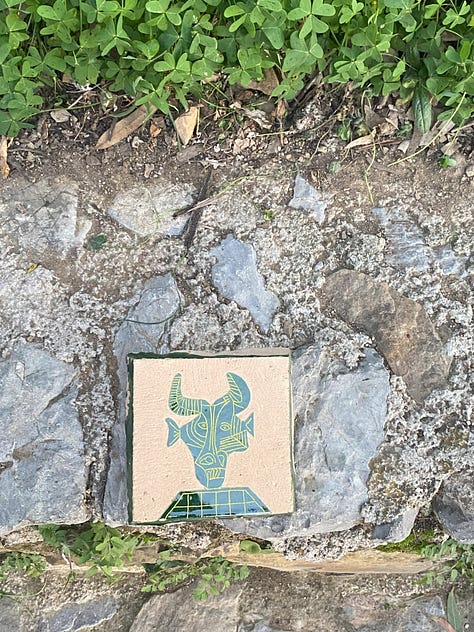
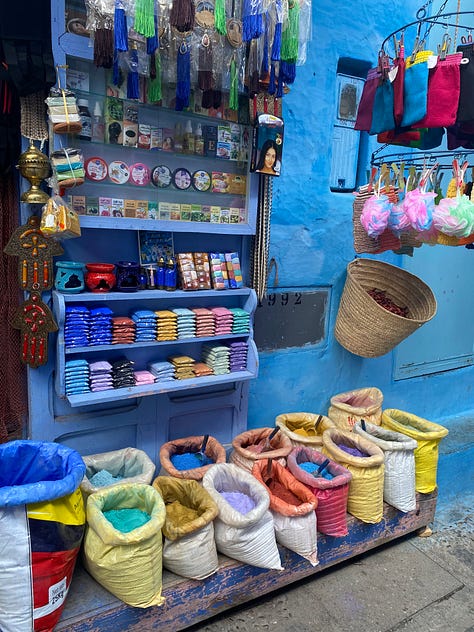
Moroccan culture allows for and encourages bargaining, so I recommend trying your hand at it at least for the experience. It was a little bit uncomfortable for me, but once I realized the vendors there are not offended by low offers and are more interested in making a deal, it soothed my uneasiness a bit. I never ended up bargaining for too much of a discount though— half probably because I was somewhat uncomfortable with it, and half because I felt like the folks there depend on tourist money. A euro or two difference on an already cheaply priced item wouldn’t hurt me too badly. Plus, I didn’t want to spend all of my time in Morocco shopping and trying to get the best deal.
I ended up with a silky soft pashmina scarf, “with two faces” as they say. That’s to say that one side of my scarf was red with orange and golden details, while the reverse side is the inverse: golden and orange with red details.
I also bought the loveliest rose-scented soap for myself and lots of Christmas gifts. A fan favorite was the terracotta lipstick: a small clay pot, the size of your hand, which is covered on the inside with a natural dye made of pomegranate and flower petals. You can rub the clay with a wet hand or oil to make the dry clay into a lipstick or blush.
Hike to the Spanish Mosque
One of our final activities in Chefchaouen was a hike up to the Spanish Mosque. It is not far from the medina, maybe a 45 minute walk depending on your pace. You’ll be walking uphill but on a path, so it’s the perfect “hike” even if you only packed city clothes (like me).
Along the path to the mosque you will watch the city of Chefchaouen get more and more distant as you begin to ascend the surrounding mountainside. On our walk we heard street performers and saw an artist etching his own tiles for sale. Eventually you’ll arrive at the small mosque which overlooks the city. As the sun set, the blue hues of Chefchaouen slowly changed, as did the color of the mountains. You won’t see the sun set per se, as it will simply disappear behind the mountains. This will give you plenty of sunlight for walking back down, though the path is also lit by streetlamps. At the mosque we sat on a stone wall and danged our feet below. We eavesdropped on conversations in Spanish the best we could, and we were even there to hear one of the five daily calls to prayer which is played on a loudspeaker from the mosque.
Sitting with your feet dangling above the city is a great opportunity to reflect on your trip to Morocco. You sit with a bunch of strangers, all using this stone wall and some stairs as a bench, waiting to watch the sun move and change the colors of the landscape around you. From above, you can watch the movement of the city below you. I never realized there were buses in Chefchaouen until I looked from above. I saw taxis and lots of motorcycles, and of course pedestrians. The city feels very vibrant and blue, like the color is surrounding you, when you are down there. But from up above you see it is a bit more subtle, more tranquil, a Blue Pearl nestled among the mountains.

